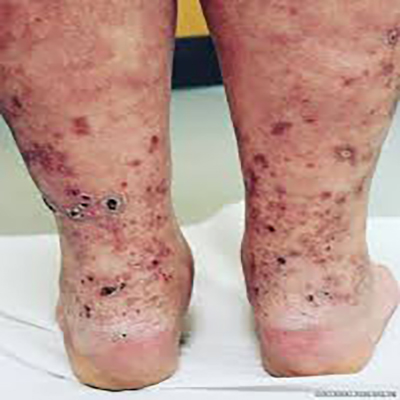Polyarteritis nodosa (PAN) is a rare, systemic necrotizing vasculitis that primarily affects medium-sized muscular arteries. It results in inflammation and damage to vessel walls, leading to aneurysm formation, thrombosis, ischemia, and organ dysfunction. Unlike other vasculitides, PAN does not involve arterioles, capillaries, or venules, and typically spares the lungs.

Etiology and Pathogenesis of PAN
Underlying Causes
The precise cause of polyarteritis nodosa remains largely idiopathic, but several triggers and associations have been identified:
- Hepatitis B virus (HBV): Strongly linked with PAN, especially in developing regions
- Hepatitis C virus (HCV)
- Hairy cell leukemia and other malignancies
- Autoimmune dysfunction
- Drug-induced immune responses
- Genetic predisposition: Rare familial PAN linked to CECR1 gene mutations
Mechanism of Vessel Damage
The cascade culminates in fibrinoid necrosis, compromising blood flow to tissues and resulting in ischemic damage in various organs.
Clinical Manifestations of Polyarteritis Nodosa
PAN presents with a wide spectrum of symptoms depending on the organ systems involved. It typically develops subacutely, progressing over weeks or months.
General Symptoms
- Fever
- Weight loss
- Fatigue
- Malaise
- Myalgias and arthralgias
Organ-Specific Involvement
| Organ System | Clinical Features |
|---|---|
| Skin | Livedo reticularis, subcutaneous nodules, ulcers, purpura |
| Renal | Hypertension, renal infarcts, proteinuria (not glomerulonephritis) |
| Neurological | Mononeuritis multiplex, peripheral neuropathy |
| Gastrointestinal | Abdominal pain, nausea, mesenteric ischemia, bowel perforation |
| Musculoskeletal | Arthralgias, muscle tenderness |
| Cardiovascular | Myocarditis, heart failure, arrhythmias |
| Genitourinary | Orchitis, testicular pain without infection |
Diagnostic Criteria and Investigations
Classification Criteria (ACR 1990)
A diagnosis of PAN can be made when at least 3 of the following 10 criteria are met:
- Unexplained weight loss > 4 kg
- Livedo reticularis
- Testicular pain or tenderness
- Myalgias or leg tenderness
- Mononeuropathy or polyneuropathy
- Diastolic BP > 90 mmHg
- Elevated BUN or creatinine
- Hepatitis B surface antigen or antibody
- Arteriographic abnormalities
- Biopsy showing necrotizing arteritis
Laboratory Tests
- ESR and CRP: Elevated in most patients
- Complete blood count: Normocytic anemia, leukocytosis
- Liver and renal function: Abnormal in systemic involvement
- Hepatitis B and C serologies
- Antineutrophil cytoplasmic antibodies (ANCA): Typically negative in PAN
- Urinalysis: Hematuria or proteinuria (due to ischemia, not glomerulonephritis)
Imaging and Biopsy
- Angiography: Microaneurysms in mesenteric, renal, or hepatic arteries are highly suggestive
- Tissue Biopsy: Gold standard showing transmural inflammation with fibrinoid necrosis of medium-sized arteries
Differential Diagnosis
When evaluating suspected PAN, it is essential to distinguish it from other vasculitides and systemic diseases:
- Microscopic polyangiitis (MPA)
- Granulomatosis with polyangiitis (Wegener’s)
- Systemic lupus erythematosus (SLE)
- Rheumatoid vasculitis
- Atherosclerotic vascular disease
Treatment Strategies for Polyarteritis Nodosa
General Approach
Early diagnosis and aggressive treatment are vital to prevent irreversible organ damage. Management varies based on disease severity and HBV association.
Corticosteroids
- First-line: Prednisone (1 mg/kg/day)
- Tapering: Gradual tapering over weeks to months based on response
Immunosuppressive Therapy
Used in moderate to severe PAN or steroid-resistant cases:
- Cyclophosphamide: Induces remission
- Azathioprine or Methotrexate: Maintenance therapy
- Mycophenolate mofetil: Alternative in specific cases
Antiviral Therapy
For HBV-associated PAN:
- Antiviral agents (e.g., tenofovir) combined with short-course steroids
- Plasma exchange: Removes immune complexes and viral particles
Supportive Care
- Blood pressure control
- Pain management
- Renal support in cases of failure
- Nutritional therapy in GI involvement
Prognosis and Complications
Prognostic Factors
- Untreated PAN: Poor prognosis with high mortality
- Treated PAN: 5-year survival > 80% with immunosuppressive therapy
Negative prognostic indicators:
- Renal dysfunction
- Gastrointestinal ischemia or perforation
- Cardiomyopathy
- CNS involvement
Potential Complications
- Chronic kidney disease
- Hypertension
- Neuropathy
- Bowel infarction
- Secondary infections from immunosuppression
Follow-Up and Monitoring
- Regular clinical assessments and laboratory testing
- Imaging for high-risk organ involvement
- Monitoring for treatment side effects, especially with cytotoxic agents
- Lifelong follow-up in chronic or relapsing cases
Frequently Asked Questions:
Is polyarteritis nodosa curable?
While there is no definitive cure, early treatment can induce long-term remission in many patients.
How common is polyarteritis nodosa?
It is a rare condition, with an incidence of 2–9 cases per million annually.
Does polyarteritis nodosa affect the lungs?
No. Unlike other vasculitides, PAN typically spares the lungs.
Can PAN recur after remission?
Yes. Relapses are possible, especially if treatment is tapered too quickly.
Is PAN hereditary?
Sporadic cases are most common, but rare familial forms exist with genetic mutations such as ADA2 deficiency.
Polyarteritis nodosa is a complex multisystem vasculitis that requires timely recognition and individualized treatment. The clinical heterogeneity of the disease mandates a high index of suspicion, especially in patients presenting with systemic symptoms and unexplained organ dysfunction. Advances in immunosuppressive therapy, antiviral management, and diagnostic imaging have significantly improved outcomes. Long-term prognosis depends on early diagnosis, the extent of organ involvement, and effective therapeutic intervention.